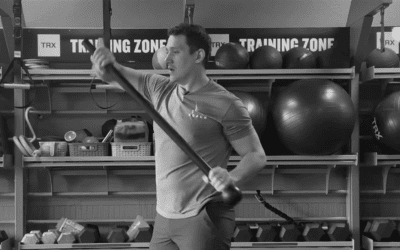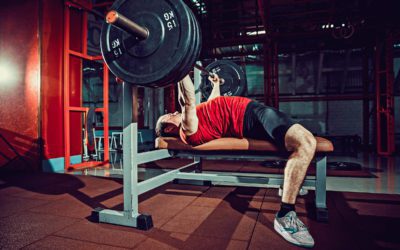6 Snatch Variations to Improve Technique, Strength, and Stability
TOPIC: Strength & Conditioning
When looking at faulty overhead stability and strength in the snatch and/or overhead squat, we typically see a wide array of issues. Sometimes it may be due to mobility (the immediate reference of everyone). But it can often be from lack of barbell awareness and placement, overhead strength, timing, and/or lack of general preparation and experience.
Therefore, in this article we will discuss:
- The importance of addressing strength and stability concerns specific to the overhead squat and snatch
- The most common reasons why lifters and athletes have poor overhead performance in both movements
- 6 exercises coaches and athletes can do immediately to address those issues and make significant improvement in their overhead squat and snatch performance

Written By
Mike Dewar
Mike holds a Masters in Applied Physiology from Columbia University and a Bachelors in Exercise Science from Bowling Green State University. He is an accredited Strength and Conditioning Specialist (NSCAS CSCS) from the National Strength and Conditioning Association and an Advanced Sports Performance Coach from USA Weightlifting (USAWL2).
Programs
Website
Why overhead stability is important (even for non-weightlifters)
Below are some reasons why training the bottoms up overhead squat is necessary for strength and stability specific to the snatch (and general overhead movements). A lot of my athletes perform mobility and movement sessions, like the ones in my functional fitness accessory program to help diversify their performance and injury-proof their bodies.
Minimize Injury and Stress
If your lifters (or yourself) become injured at any point in training, long-term performance goals may need to be adjusted, which means slower results. In weightlifting, the wrists, elbows, and shoulders are key joints necessary for lifts (as they are highly involved in the proper execution and stability needed when going into receiving positions of the snatch, clean, and jerk). Increasing injury resilience through proper joint function, bar placement, and muscular development is essential to consistent training and long-term results.
Increased Lockout Strength
Increasing your ability to hold loads overhead properly and with full elbow and wrist stabilization will allow you to set your spine, upper back, and pelvis in the correct position to squat in a vertical fashion. Failure to have a comfortable and solid lock out in the snatch and overhead squat position will result in issues up and down the chain (over-extended wrists, excessive leaning forward of torso, lack of knee and ankle flexion, etc.).
Maximal Upper Back Tension
Overhead squats, presses, and other overhead strength and stability movements work wonders for upper back development. The traps, scapular stabilizers, rhomboids, and shoulders all play a critical role in the receiving stages of the snatch (as well as throughout most weightlifting movements). They can be specifically trained in a very sport-specific fashion (to weightlifting and the snatch) through many of the exercises below.
Enhanced Confidence Under Heavy Lifts
Biomechanics and weightlifting technique aside, lifter confidence in his/her abilities is HUGE for maximal performance. Training overhead strength and stability will provide the lifter the confidence they need to fix themselves aggressively (and without hesitation) under heavy singles and PR attempts.
Lift More Weight
While not all of us lift day in and day out to crush PRs and take names (sports athletes who perform snatches don’t necessarily need to lift heavier than 70-75%, as speed and explosiveness is key, not the weightlifting total), the ability to perform explosive lifts with progressively more weight will often result in a more powerful athlete (duh).
Increasing all of the aspects above most certainly will set you up to lift heavier loads (at the same velocities) with greater precision, stability, and results.
Poor Overhead Strength Issues and Causes
Below are typical issues and causes of poor overhead strength and stability during the snatch and overhead squat.
Bar Placement
Sometimes lifters just lack proprioception and muscle memory when performing snatches and overhead squats, ultimately resulting in inconsistent bar placement (which then leads to a slew of other issues…keep reading).
Behind the neck movements, like the ones below, are a great way to develop the neurological awareness and muscle necessary for proper barbell placement in the overhead position.
Lack of Wrist and Elbow Joint Stability/Strength
Floppy wrists will not help us one bit in the weight room. Lack of wrist and elbow stability will result in energy leakages and excessive strain on the tiny tendons and ligaments surrounding those joints. Instead of asking small connective tissues to stabilize heavy loads overhead, often being received at high velocities, why not build better movement patterns and serious structural strength by using some of the exercises below?
Lack of Upper Back Development
As discussed above, the upper back is key to Olympic weightlifting, squatting, pulling, and general movement and fitness. Weak trap, spinal extensions, scapular stabilizers, and more will result in excessive leaning of the torso in overhead movements and potentially heavier weights crashing down onto a lifter in the snatch.
Improper Squat Patterning
Many issues with poor overhead squats may not result from knee or ankle mobility (however, they might…see below). Rather, poor squat patterning can be a result of any of the issues listed in this section.
By addressing all these issues (by using the exercises below), you can set your lifter up to perform better movement as a whole due to greater stability, awareness, and strength throughout the range of motion.
Poor Flexibility and Mobility
This is often the first thing lifters and coaches look at when determining why someone has issues getting into stable squats and receiving positions. While I agree that this can be the reason why, simply doing endless mobility drills is a misguided approach.
If someone can exhibit the necessary movement pattern (done by testing specific ankle mobility or thoracic extension tests, rather than saying “since they can’t do overhead squat, it MUST be their ankles”…). The fact of the matter is they may just be bad at overhead squats and have the mobility.
Lack of Confidence
Lack of confidence, whether conscious or subconscious, will slow any explosive and involuntary process down to a crawl. Building in confidence is key to long-term skill development in the snatch and weightlifting as a whole, which is why the exercises below should be used equally throughout a well-balanced program.
6 Snatch Variations to Improve Overhead Strength, Stability, and Technique
Explore these six snatch variations to enhance your overhead strength, stability, and technique for a more effective weightlifting regimen.
1) Behind the Neck Seated/Standing Snatch Press
Building strength and stability in the upper back and posterior shoulder is key to maximizing overhead performance in the snatch and developing the upper back strength to handle heavy loads.
Weightlifters and CrossFit athletes often skip out on hypertrophy sessions which is unfortunate as it can build new muscle fibers, increase movement patterning, and help develop sound barbell placement and awareness specific to the overhead squat and snatch.
Try doing this strict seated press variation (which increases upper back and shoulder demands more than standing) one to two times per week for 4 sets of 4-6 repetitions with a moderate to heavy load, holding each rep at the top for two seconds to increase overhead stability.
2) Snatch Push Press + Overhead Squat
What a wonderful way to increase serious overhead stability and strength AND have it translate immediately to your sport-specific movement. Building this snatch push press + overhead squat complex into accessory training or strength-based days can help you gain shoulder mass and increase upper back and leg strength.
Try doing these with 80-90% of your snatch max for 4-6 sets of 1-3 snatch push presses plus 1-3 overhead squats.
3) Clean Grip Overhead Squats
Narrowing the grip in the overhead squat will force you to really increase upper back and trap engagement and have a seriously strong overhead lockout. The added mobility needed to take a narrower grip is something to be aware of; however, over time it can be improved by simply performing the overhead squat with a slightly narrower than normal grip.
Try performing these with 60-70% of your clean and jerk during clean and jerk sessions (for example power clean + jerk + clean grip overhead squat) or with 70-90% of your snatch for 4 sets of 3-5 repetitions.
4) Snatch Balance
The snatch balance is no secret these days, yet so many people fail to do them and/or do them incorrectly.
Snatch balances can be done with heavy loads (similar to exercise #2) to build strength, confidence, and proper timing for getting into a stable squat/reviving position. They can also be done with moderate loading to allow a lifter to explosively drive themselves into a deeper receiving poison (at around parallel) in which they can then catch the bounce at the bottom of the squat to react and recover, which can be helpful for heavier snatches.
Both methods, however, should focus on the timing (dip, drive, punch… 1,2,3) and balance of the movement. Catching the load high, resetting the feet, and slowly overhead squatting is basically a snatch push press + overhead squat. Snatch balances require a sense of speed, aggression, and proprioception to place the feet where they need to go with little thought during the actual lift.
Try doing snatch balances with similar loading schemes as exercise #2.
5) Behind the Neck Snatch Press in Squat
This is basically a slower version of a snatch balance, with the lifter performing a strict snatch press from behind the neck while simultaneously pressing themselves downwards away from the barbell into a deep overhead squat. This teaches the concepts of pressing oneself under the barbell, and increasing barbell partnering and awareness.
Try partnering this with lighter loads, similar to loading schemes you would use in exercise #1.
6) Overhead Holds (at end of lifts)
This one is so simple to add into nearly every snatch, overhead squat, or jerk session. Simply hold the weight overhead in a stable and locked out position for 10 seconds at the end of your heaviest work sets.
This may be at the top of the snatch and jerk (like you would need to do in an official weightlifting meet), or at the bottom of the overhead squat/snatch (I love the results I have gotten from holding snatches overhead in the deep squat position for 5-10 seconds).
This will help you gain awareness, build lockout strength, and gain confidence under heavy loads.
Choosing the appropriate exercise is half the battle. Creating a loading prescription library will organize your workflow and give you the power of precision when writing training programs.
Final Thoughts
Hope these tips and exercises help you with your own training and programming for Olympic Weightlifting and/or general snatch training for CrossFit and sports performance.
If you are a coach and/or athlete looking for a complete program that encompasses many of these movements (as well as a plethora of others), be sure to check out my weightlifting team programming (coach and athletes licenses) and/or the functional strength and fitness programming for sports and Crossfit athletes alike.
Find Your Perfect Training Plan
Sometimes all you need to reach your destination on your fitness journey is an expert guide. Look no further, we've got you covered. Browse from thousands of programs for any goal and every type of athlete.
Try any programming subscription FREE for 7 days!
Related Articles
You May Also Like...
The Ultimate Guide to Lunges: Queen of all Glute Exercises
Your glutes are the largest muscle group in your body. They’re responsible for almost everything your legs do—walking, running, jumping, squatting, lunging, and just standing upright. As far as moving through space goes, strong glutes are the bedrock of overall...
A Beginner’s Guide to Steel Mace Training
Think you’ve mastered kettlebells? Meet the steel mace — the brutal, offset weapon that forces your body into three-dimensional stability, grip work, and rotational strength. Ancient tool. Modern performance.Written Byjesse grund Jesse Grund’s passion is simple: coach...
The Best Bench Press Warm Up Strategy
We get it. You’re pressed for time in the gym. But skipping the warm up is the surest way to underperform and risk injury. This 3D approach to your bench press warm up not only allows you to lift more weight, but also ensures the long-term health of your shoulder...
The Ultimate Guide to Lunges: Queen of all Glute Exercises
Your glutes are the largest muscle group in your body. They’re responsible for almost everything your legs do—walking, running, jumping, squatting, lunging, and just standing upright. As far as moving through space goes, strong glutes are the bedrock of overall...
A Beginner’s Guide to Steel Mace Training
Author: Jesse Grund
Mace training will make you a better mover without it’s not confining you to a fixed space or predetermined range of motion. Second, it’s an offset load with 80 to 90 percent of the weight in the head. You’re also constantly having to resist rotation, which creates greater core engagement.

Want more training content?
Subscribe
For Coaches
For Athletes
About
Support
Training Lab
Access the latest articles, reviews, and case studies from the top strength and conditioning minds in the TH Training Lab!
Made with love, sweat, protein isolate and hard work in Denver, CO
© 2024 TrainHeroic, Inc. All rights reserved.





